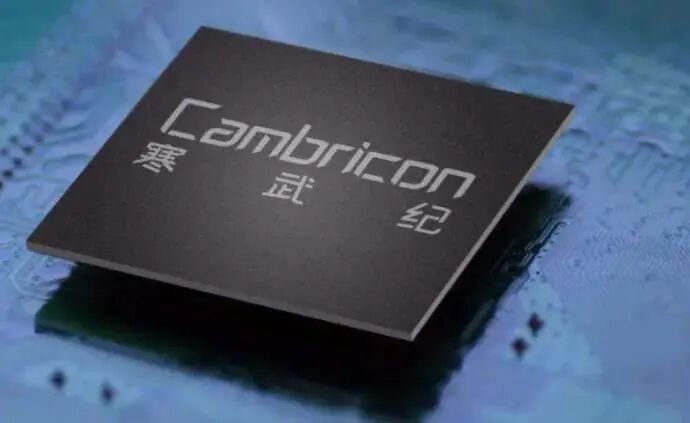Revenue surged by 4230.22% year-on-year? After being “highly anticipated” for many years, domestic AI chip leader Cambricon has finally delivered an astonishing performance report.
On the evening of April 18, Cambricon released its Q1 2025 financial report, with quarterly revenue reaching 1.111 billion yuan, a year-on-year increase of 4230.22%, and a net profit of 355 million yuan, marking a historic turnaround from losses, making it one of the brightest tech stocks in the A-share market. In comparison, last year’s revenue was only 25.67 million yuan, with a loss of 227 million yuan; this level of leap can be described as a “transformation”.
Multiple brokerage firms have released research reports describing Cambricon’s performance as “beyond expectations”. Guohai Securities upgraded its rating to “Buy”, while Minsheng Securities also gave a “Recommended” rating.

Cambricon’s Path to Success with Domestic Chips
Since its debut on the STAR Market, Cambricon, adorned with the title of “the first AI chip stock”, has been seen as a symbol of hope for China’s AI chip industry.
Previously, Cambricon had been controversial due to the divergence between its fundamentals and stock price trends. Since its listing, Cambricon has been in a state of continuous losses. While facing ongoing losses, the company’s R&D expenses have significantly exceeded its revenue scale. In 2023 and the first three quarters of 2024, with revenue of only 709 million yuan and 185 million yuan, the company’s R&D expenses reached 1.118 billion yuan and 659 million yuan, respectively.
However, against the backdrop of escalating Sino-U.S. trade tensions and the U.S. government’s tightening of export controls on high-performance AI chips to China, Cambricon has entered a critical “window period”.

Faced with the urgent demand for high-performance computing power from large domestic tech companies and the anxiety over “supply cuts”, Cambricon has quickly filled the market gap with its products. Although it still faces challenges in many areas, under the realistic conditions of minimal performance differences and being “available and controllable”, Cambricon’s products have become a notable alternative in the current Chinese market as a “non-NVIDIA option”.
It is against the backdrop of accelerated “domestic substitution” that Cambricon’s main business revenue achieved explosive growth in Q1 2025. At the same time, the company maintained a relatively stable gross margin of about 56%. The net profit after deducting non-recurring gains and losses also reached 276 million yuan, successfully turning a profit.
The company continues to maintain a high-intensity pace of technological breakthroughs, with R&D spending in the first quarter reaching 235 million yuan, a year-on-year increase of 38.33%. However, thanks to the sharp expansion of revenue scale, the proportion of R&D expenses to operating income has significantly decreased from over 660% in the same period last year to 21.11%. The company emphasized in its financial report that it is “one of the few companies in the industry that has comprehensively mastered the core technologies of intelligent chip and its underlying system software R&D and productization”, which is a key factor for Cambricon to maintain its advantage in fierce competition.
NVIDIA A100 Alternative? Cambricon Chips Gaining Customer Recognition
Behind this round of explosive performance, the enhancement of product strength is a key factor. From the product structure perspective, the cloud product line is the core engine of Cambricon’s revenue growth. This product line achieved a year-on-year growth of 1187.78% in 2024, with revenue reaching 1.166 billion yuan, accounting for 99.3% of the total annual revenue.

Among Cambricon’s many products, its self-developed Siyuan 590 chip stands out. According to internal testing results from Baidu, Siyuan 590 supports the vast majority of mainstream models. In certain large model training tasks, the performance of Siyuan 590 is very close to that of the A100; even in relatively weaker scenarios, its performance can reach about half of the A100’s; overall performance is roughly at 80% of the A100 level. This capability, which directly competes with top international products, has earned Siyuan 590 considerable recognition in the industry, being regarded as one of the most powerful domestic alternatives to NVIDIA’s A100.
At the same time, Cambricon’s advancement in commercialization is no longer just “talking the talk”. In 2024, the company’s first client is a long-term partner, whose procurement amount accounts for 79.15% of the company’s annual sales, mainly due to the continuous improvement of the competitiveness of the company’s intelligent chip products, which have gained recognition from the client, leading to increased procurement this period.
Strategic Window Under U.S. Pressure: A Challenge and an Opportunity
In a broader context, this chip breakthrough battle is not only a market game between enterprises but also a strategic projection of the Sino-U.S. tech cold war. Over the past three years, the U.S. has continuously introduced export control policies, attempting to sever the “computing power nerve” of China’s AI industry. In the face of the reality of “supply cuts”, the Chinese government has responded swiftly, from the construction of intelligent computing centers, the “East Data West Computing” project, to local governments promoting the procurement of domestic chips, a complete set of policy combinations has opened up a path for the development of local AI chips.
Cambricon is a core beneficiary of this strategic channel. In 2024, the company has won multiple government project bids, significantly increasing the proportion of revenue from government procurement, which has become a key support for its turnaround.

However, the breakthrough battle for domestic AI chips is far from over. Today, the U.S. continues to tighten high-end chip exports and has initiated a new round of tariffs on goods from China, with technological decoupling spreading from “algorithm restrictions” to “hardware blockades”. This presents new challenges and a reality that the entire industry must face.
However, it is precisely under such pressure that opportunities emerge.“Being blocked” is accelerating the push for “self-reliance”. When technological supply cuts become the norm, independent R&D is no longer a choice but the only solution. The road from “being choked” to “choking back” is still long, but Cambricon’s profitability turnaround is undoubtedly a signal: local forces are awakening.
As some commentators have said: every time we are shut out, it marks the beginning of a reconstruction of the industrial chain. Challenges are intensifying, and time will not stand still. In the face of blockades, the spring of Chinese chips may be hidden behind the next ban.
Source: Daily Economic News, Caixin, etc.
(Edited by Wang Jiayi, Integrated by Li Mengbo and Zhang Chen)
